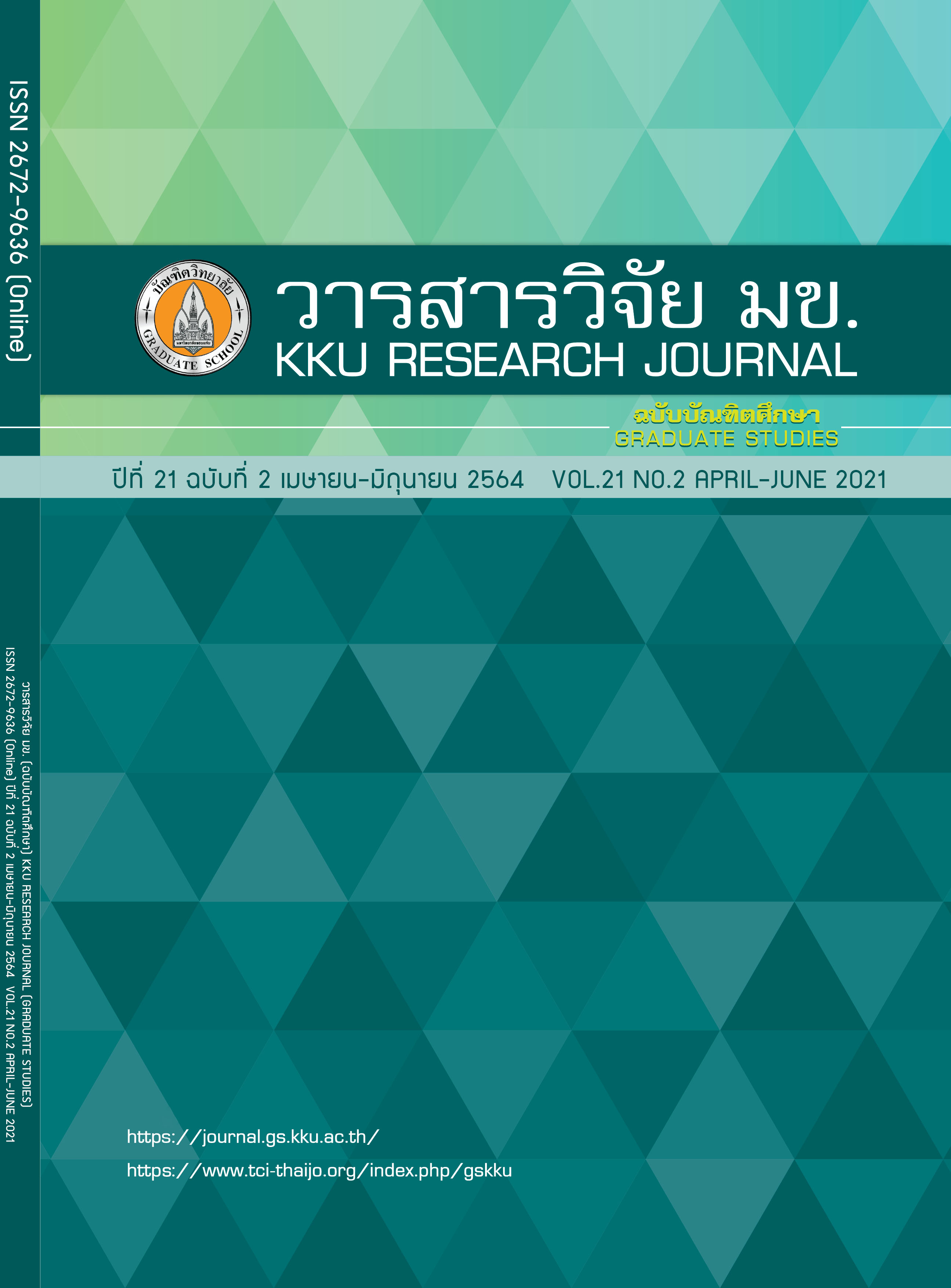Proteomics and Transcriptomics Studies in Nonreplicating Persistence of Mycobacterium tuberculosis Beijing and Non-Beijing Strains
Keywords:
Mycobacterium tuberculosis, Multiple stresses, BeijingAbstract
Latent tuberculosis infection (LTBI) is an infectious disease which the pathogen can behave as non-replicating persistent (NRP) or dormancy cells, and it caused by Mycobacterium tuberculosis (Mtb) strains. Beijing and non-Beijing strains have been reported and suggested to facilitate rise of the re-infection rate in regions with a high incidence of TB disease. To better understanding of molecular mechanisms and explore biomarker of the pathogen via NRP stage, mimicking condition is thought to reflect of Mtb inside the host granulomas (intracellular environment). The experiments have been designed by hypoxia, low pH, iron deprivation and nutrient starvation. Proteins prepared from multiple stress cultures, were then performed in-gel digestion with Trypsin and characterized by Liquid chromatography tandem mass spectrometry and then validated by quantitative real-time PCR. The results showed that strains Beijing found to be up-regulation of cyp123, Rv1496, ppgK and folP1 and non-Beijing found to be up-regulation of mce1R and Rv1501. The unique feature of proteins presents in this study that allowed the investigation and identification of Mtb strains during multiple stresses. Which further benefit for identification of potential biomarkers lead to discovery new drug targets and vaccine development.
References
Huang H-Y, Tsai Y-S, Lee J-J, Chiang M-C, Chen Y-H, Chiang C-Y, et al. Mixed infection with Beijing and non-Beijing strains and drug resistance pattern of Mycobacterium tuberculosis. Journal of clinical microbiology. 2010;48(12):4474-4480.
Deb C, Lee C-M, Dubey VS, Daniel J, Abomoelak B, Sirakova TD, et al. A novel in vitro multiple-stress dormancy model for Mycobacterium tuberculosis generates a lipid-loaded, drug-tolerant, dormant pathogen. PloS one. 2009;4(6):e6077.
Gao X, Chen J, Tong Z, Yang G, Yao Y, Xu F, et al. Interleukin-10 promoter gene polymorphisms and susceptibility to tuberculosis: a meta-analysis. PloS one. 2015;10(6).
Shitikov E, Kolchenko S, Mokrousov I, Bespyatykh J, Ischenko D, Ilina E, et al. Evolutionary pathway analysis and unified classification of East Asian lineage of Mycobacterium tuberculosis. Scientific reports. 2017;7(1):9227.
Kato-Maeda M, Kim E, Flores L, Jarlsberg L, Osmond D, Hopewell P. Differences among sublineages of the East-Asian lineage of Mycobacterium tuberculosis in genotypic clustering. The international journal of tuberculosis and lung disease. 2010;14(5):538-544.
Luo T, Comas I, Luo D, Lu B, Wu J, Wei L, et al. Southern East Asian origin and coexpansion of Mycobacterium tuberculosis Beijing family with Han Chinese. Proceedings of the National Academy of Sciences. 2015;112(26): 8136-8141.
Kendall S, Movahedzadeh F, Rison S, Wernisch L, Parish T, Duncan K, et al. The Mycobacterium tuberculosis dosRS two-component system is induced by multiple stresses. Tuberculosis. 2004;84(3-4):247-255.
MacNeil A, Glaziou P, Sismanidis C, Maloney S, Floyd K. Global epidemiology of tuberculosis and progress toward achieving global targets—2017. Morbidity and Mortality Weekly Report. 2019;68(11):263.
Kaewseekhao B, Naranbhai V, Roytrakul S, Namwat W, Paemanee A, Lulitanond V, et al. Comparative proteomics of activated THP-1 cells infected with Mycobacterium tuberculosis identifies putative clearance biomarkers for tuberculosis treatment. PloS one. 2015;10(7).
Saiboonjan B, Faksri K, Namwat W. Transcriptional Expression of Acidic-stress Responsive Genes in Mycobacterium tuberculosis. The national research conference 34th. 2015:1099-1105.
Haile Y, Bjune G, Wiker HG. Expression of the mceA, esat-6 and hspX genes in Mycobacterium tuberculosis and their responses to aerobic conditions and to restricted oxygen supply. Microbiology. 2002;148(Pt 12):3881-3886.
Stavrum R, Valvatne H, Bø TH, Jonassen I, Hinds J, Butcher PD, et al. Genomic diversity among Beijing and non-Beijing Mycobacterium tuberculosis isolates from Myanmar. PloS one. 2008;3(4).
Rodríguez-Castillo JG, Pino C, Niño LF, Rozo JC, Llerena-Polo C, Parra-López CA, et al. Comparative genomic analysis of Mycobacterium tuberculosis Beijing-like strains revealed specific genetic variations associated with virulence and drug resistance. Infection, Genetics and Evolution. 2017;54:314-323.
Caws M, Thwaites G, Dunstan S, Hawn TR, Lan NT, Thuong NT, et al. The influence of host and bacterial genotype on the development of disseminated disease with Mycobacterium tuberculosis. PLoS pathogens. 2008;4(3):e1000034.
Rodriguez GM, Voskuil MI, Gold B, Schoolnik GK, Smith I. ideR, an essential gene in Mycobacterium tuberculosis: role of IdeR in iron-dependent gene expression, iron metabolism, and oxidative stress response. Infection and immunity. 2002;70(7):3371-3381.
Mawuenyega KG, Forst CV, Dobos KM, Belisle JT, Chen J, Bradbury EM, et al. Mycobacterium tuberculosis functional network analysis by global subcellular protein profiling. Molecular Biology of the cell. 2005;16(1):396-404.
McLean KJ, Dunford AJ, Neeli R, Driscoll MD, Munro AW. Structure, function and drug targeting in Mycobacterium tuberculosis cytochrome P450 systems. Archives of biochemistry and biophysics. 2007;464(2):228-240.
Hsieh P, Shenoy B, Jentoft J, Phillips N. Purification of polyphosphate and ATP glucose phosphotransferase from Mycobacterium tuberculosis H37Ra: evidence that poly (P) and ATP glucokinase activities are catalyzed by the same enzyme. Protein expression and purification. 1993;4(1):76-84.
Hsieh P-C, Kowalczyk TH, Phillips NF. Kinetic mechanisms of polyphosphate glucokinase from Mycobacterium tuberculosis. Biochemistry. 1996;35(30):9772-9781.
Nopponpunth V, Sirawaraporn W, Greene PJ, Santi DV. Cloning and expression of Mycobacterium tuberculosis and Mycobacterium leprae dihydropteroate synthase in Escherichia coli. Journal of bacteriology. 1999;181(21):6814-6821.
Casali N, White AM, Riley LW. Regulation of the Mycobacterium tuberculosis mce1 operon. Journal of bacteriology. 2006;188(2):441-449.
Ru H, Liu X, Lin C, Yang J, Chen F, Sun R, et al. The impact of genome region of Difference 4 (RD4) on mycobacterial virulence and BCG efficacy. Frontiers in cellular and infection microbiology. 2017;7:239.



